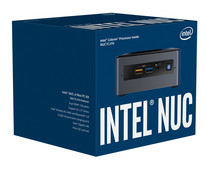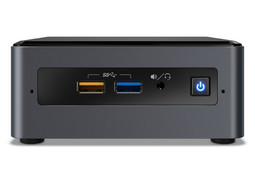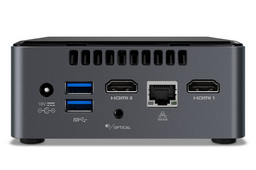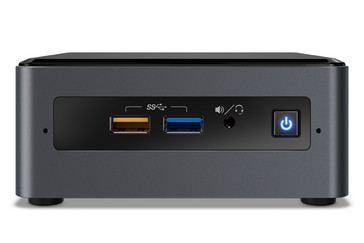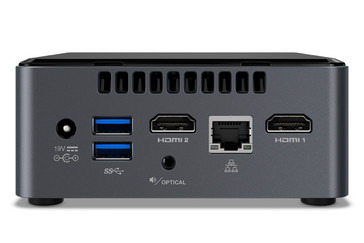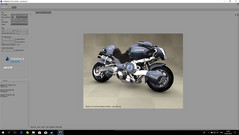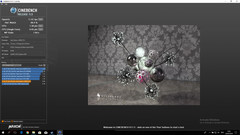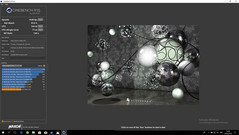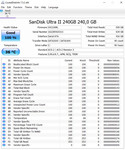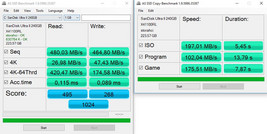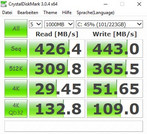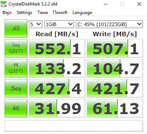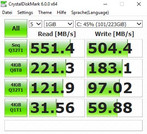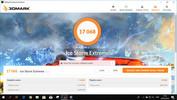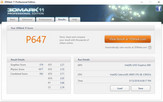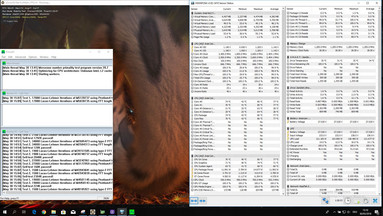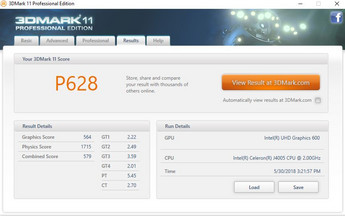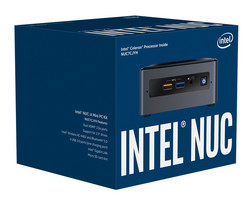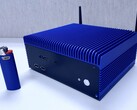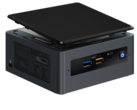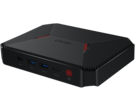Recensione del Mini PC Intel NUC Kit NUC7CJYH (Celeron J4005, UHD 600)
NUC è la gamma Mini PC di Intel. Intel li vende sotto forma di kit o come macchine completamente funzionanti. Le scelte hardware variano dal livello base fino a quello estremo, quest'ultimo include un processore Intel Core i7-8890G. Il nostro dispositivo di prova è il kit Intel NUC NUC7CJYH, che è alimentato da un processore Intel Celeron J4005 entry-level. Il J4005 è una CPU desktop da 14 nm basata sull'architettura Intel Gemini Lake. Il J4005 è una CPU dual-core da 10 W con una velocità di clock di base di 2,0 GHz che può aumentare fino a 2,7 GHz quando richiesto e 4 MB di cache. Il J4005 include una Intel UHD Graphics 600, una GPU integrata che dispone di dodici unità di esecuzione (UE).
Il NUC7CJYH è dotato di un alimentatore da 65 W, di un supporto VESA e della documentazione sul Mini PC. Vale la pena ricordare che il kit non include un sistema operativo, una RAM o una memoria interna.
Se avete bisogno di un po' più di potenza, c'è il NUC7PJYH, un Kit che include un processore Intel Pentium J5005. Il J5005 è una CPU quad-core Gemini Lake da 10 W che supporta frequenze comprese tra 1,5 e 2,8 GHz. Tuttavia, al NUC7PJYH mancano anche il sistema operativo, la RAM e la memoria interna.
Se questo non vi attira, Intel offre numerosi NUC Mini PC con specifiche simili, ma con i componenti che il NUC7CJYH omette. Intel offre attualmente il NUC7CJYSAL, che aggiunge Windows 10, 4 GB di RAM DDR4-2400 SO-DIMM e un'unità eMMC da 32 GB.
I nostri Top 10
» Top 10 Portatili Multimedia
» Top 10 Portatili Gaming
» Top 10 Portatili Gaming Leggeri
» Top 10 Portatili da Ufficio e Business economici
» Top 10 Portatili Premium da Ufficio/Business
» Top 10 Portatili sotto i 300 Euro
» Top 10 Portatili sotto i 500 Euro
» Top 10 dei Portatili Workstation
» Top 10 Subnotebooks
» Top 10 Ultrabooks
» Top 10 Convertibili
» Top 10 Tablets
» Top 10 Tablets Windows
» Top 10 Smartphones
Case & Dotazioni
Il case è dominato da plastica e metallo. La combinazione di materiali contribuisce a conferire al NUC7CJYH un aspetto di qualità e gli conferisce una sensazione di robustezza e solidità. La parte superiore ha una finitura lucida che raccoglie rapidamente le impronte digitali e micrograffi. La piastra inferiore è fissata con quattro piccole viti. Lo svitamento permette il distacco della piastra inferiore e l'accesso ai componenti interni. Intel ha incluso un supporto VESA nella confezione, che consente di montare il NUC7CJYH su un monitor o su una parete.
Le porte sono distribuite su tre lati e la maggior parte di esse è posizionata da Intel sul retro del dispositivo. Complessivamente, ci sono quattro porte USB 3.0 di tipo A e due porte HDMI. La parte anteriore del dispositivo è dotata di due porte USB, un jack per cuffie e microfono da 3,5 mm e un pulsante di alimentazione. Sul retro, ci sono le due porte USB rimanenti, due porte HDMI, una porta Ethernet RJ45, un connettore audio ottico e un connettore di alimentazione. Sono inoltre disponibili un lettore di schede SD e uno slot di blocco sul lato sinistro. Sarebbe stato bello se Intel avesse incluso una porta USB di tipo C, magari per le varianti NUC più costose.
Il nostro dispositivo di prova pesa 577 g e l'alimentatore 330 g.
Performance
Il NUC7CJYH è abbastanza potente per applicazioni semplici da ufficio grazie al suo processore entry-level e alla debole GPU integrata.
Processore
Il NUC7CJYH è alimentato da un Intel Celeron J4005, un processore dual-core da 10 W con 4 MB di cache. La CPU ha una velocità di clock di base di 2,0 GHz che può aumentare fino a 2,8 GHz quando richiesto. Non c'è supporto per l'Hyper-Threading, quindi ci sono solo due thread che girano in parallelo. Il fattore che limita le prestazioni è il TDP da 10 W, che sia la CPU che la GPU condividono. Così, sebbene la CPU funzioni a 2,6 GHz nei soli test di stress della CPU, scende a 2,4 GHz quando si eseguono contemporaneamente i test di stress della CPU e della GPU. Le prestazioni del singolo core sono migliorate rispetto alle precedenti generazioni di Celeron, ma gli acquirenti non dovrebbero aspettarsi nulla di buono da Celeron J4005.
| Cinebench R15 | |
| CPU Single 64Bit | |
| Intel Core i5-7200U | |
| Intel Core i5-6260U | |
| Intel Core i5-5250U | |
| Intel Core i3-5010U | |
| Intel Celeron J4005 | |
| Intel Pentium N4200 | |
| Intel Celeron N3450 | |
| CPU Multi 64Bit | |
| Intel Core i5-7200U | |
| Intel Core i5-6260U | |
| Intel Core i5-5250U | |
| Intel Core i3-5010U | |
| Intel Core i3-5010U | |
| Intel Pentium N4200 | |
| Intel Celeron J4005 | |
| Intel Celeron N3450 | |
| Cinebench R11.5 | |
| CPU Single 64Bit | |
| Intel Core i5-7200U | |
| Intel Core i5-6260U | |
| Intel Core i5-5250U | |
| Intel Celeron J4005 | |
| Intel Pentium N4200 | |
| CPU Multi 64Bit | |
| Intel Core i5-7200U | |
| Intel Core i5-6260U | |
| Intel Core i5-5250U | |
| Intel Pentium N4200 | |
| Intel Celeron J4005 | |
| Cinebench R10 | |
| Rendering Single CPUs 64Bit | |
| Intel Core i5-5250U | |
| Intel Celeron J4005 | |
| Rendering Multiple CPUs 64Bit | |
| Intel Core i5-5250U | |
| Intel Celeron J4005 | |
| Blender - v2.79 BMW27 CPU | |
| Intel Celeron J4005 | |
| wPrime 2.10 | |
| 1024m | |
| Intel Celeron J4005 | |
| Intel Core i3-5010U | |
| Intel Pentium N4200 | |
| Intel Core i5-5250U | |
| Intel Core i5-6260U | |
| Intel Core i5-7200U | |
| 32m | |
| Intel Celeron J4005 | |
| Intel Core i3-5010U | |
| Intel Pentium N4200 | |
| Intel Core i5-5250U | |
| Intel Core i5-6260U | |
| Intel Core i5-7200U | |
| X264 HD Benchmark 4.0 | |
| Pass 2 | |
| Intel Core i5-6260U | |
| Intel Core i5-5250U | |
| Intel Core i3-5010U | |
| Intel Pentium N4200 | |
| Intel Celeron J4005 | |
| Pass 1 | |
| Intel Core i5-6260U | |
| Intel Core i5-5250U | |
| Intel Core i3-5010U | |
| Intel Pentium N4200 | |
| Intel Celeron J4005 | |
| WinRAR - Result | |
| Intel Core i5-5250U | |
| Intel Core i5-6260U | |
| Intel Core i3-5010U | |
| Intel Pentium N4200 | |
| Intel Celeron J4005 | |
| TrueCrypt | |
| Serpent Mean 100MB | |
| Intel Core i5-7200U | |
| Intel Pentium N4200 | |
| Intel Core i5-6260U | |
| Intel Core i5-5250U | |
| Intel Core i3-5010U | |
| Intel Celeron J4005 | |
| Twofish Mean 100MB | |
| Intel Core i5-7200U | |
| Intel Core i5-6260U | |
| Intel Core i5-5250U | |
| Intel Pentium N4200 | |
| Intel Core i3-5010U | |
| Intel Celeron J4005 | |
| AES Mean 100MB | |
| Intel Core i5-7200U | |
| Intel Core i5-6260U | |
| Intel Core i5-5250U | |
| Intel Pentium N4200 | |
| Intel Core i3-5010U | |
| Intel Celeron J4005 | |
| Geekbench 4.4 | |
| 64 Bit Multi-Core Score | |
| Intel Core i3-5010U | |
| Intel Celeron N3450 | |
| Intel Celeron J4005 | |
| 64 Bit Single-Core Score | |
| Intel Core i3-5010U | |
| Intel Celeron J4005 | |
| Intel Celeron N3450 | |
* ... Meglio usare valori piccoli
Risultati Cinebench R15
Grazie al sistema di raffreddamento discreto del NUC7CJYH, durante il test di benchmark multi loop Cinebench R15 la CPU non ha subito rallentamenti dovuti alle temperature. Il nostro dispositivo di test ha funzionato costantemente durante il ciclo Cinebench R15, con una media di 144 punti nel test multi-core e 77 punti nel test single-core. I benchmark indicano che Celeron J4005 ha più del 30% di prestazioni single core migliori rispetto ai chip Pentium e Celeron più vecchi, ma il 13% di prestazioni multi-core peggiori rispetto all'Intel Pentium N4200. Indipendentemente dal test, il Celeron J4005 è significativamente dietro le sue controparti Intel Core ix.
Prestazioni di sistema
Naturalmente, l'hardware scelto per trasformare il NUC7CJYH in una macchina da lavoro influirà sulle prestazioni del sistema. Un HDD convenzionale rallenta il funzionamento del sistema rispetto a un'unità SSD installata in precedenza. Questo vale anche per la RAM. Una maggiore RAM andrà a beneficio delle prestazioni del sistema fino a un certo punto, a seconda delle applicazioni in esecuzione. Gli utenti poco esigenti probabilmente non noteranno la differenza tra 8 GB e 16 GB di RAM, mentre gli utenti più esigenti lo noteranno. Inoltre, l'utilizzo di due moduli RAM abiliterà la modalità dual-channel, che offre un leggero aumento delle prestazioni rispetto alla modalità single-channel. Abbiamo dotato il nostro dispositivo di prova di 8 GB di RAM DDR4-2400 e di un'unità SSD SanDisk. Il NUC7CJYH dispone di un alloggiamento per unità da 2,5". Uno slot M.2-2280 avrebbe consentito l'installazione di SSD e NVMe più veloci, migliorando ulteriormente le prestazioni del sistema.
I risultati nei benchmark PCMark sono simili a quelli dei benchmark della CPU. Celeron J4005 è facilmente più veloce del Pentium N4200, ma non riesce a tenere il passo con le significative CPU Core ix.
Nel complesso, il NUC7CJYH è abbastanza potente per le applicazioni semplici da ufficio. La CPU raggiunge rapidamente i suoi limiti con diverse applicazioni in primo piano, portando a notevoli rallentamenti. Lo stesso principio vale per l'apertura di troppe schede del browser, che bloccano rapidamente il sistema. Suggeriamo di valutare attentamente se il NUC7CJYH è il Mini PC giusto per l'utente se è necessario eseguire più applicazioni e più schede browser contemporaneamente.
| PCMark 8 | |
| Work Score Accelerated v2 | |
| Intel NUC6i5SYH, Intel Core i5-6260U | |
| Dell Latitude 5580, Intel Core i5-7200U | |
| Intel NUC5i5RYH, Intel Core i5-5250U | |
| Intel NUC5i3RYK, Intel Core i3-5010U | |
| Intel NUC7CJYH, Intel Celeron J4005 | |
| Acer Aspire ES1-332-P91H, Intel Pentium N4200 | |
| Home Score Accelerated v2 | |
| Intel NUC6i5SYH, Intel Core i5-6260U | |
| Dell Latitude 5580, Intel Core i5-7200U | |
| Intel NUC5i5RYH, Intel Core i5-5250U | |
| Intel NUC5i3RYK, Intel Core i3-5010U | |
| Intel NUC7CJYH, Intel Celeron J4005 | |
| Acer Aspire ES1-332-P91H, Intel Pentium N4200 | |
| Acer Spin 1 SP111-31-C79E, Intel Celeron N3450 | |
| PCMark 7 | |
| Score | |
| Intel NUC7CJYH, Intel Celeron J4005 | |
| Acer Aspire ES1-332-P91H, Intel Pentium N4200 | |
| Productivity | |
| Intel NUC7CJYH, Intel Celeron J4005 | |
| Acer Aspire ES1-332-P91H, Intel Pentium N4200 | |
Dispositivi di archiviazione
Abbiamo dotato il nostro dispositivo di test di un SSD SanDisk Ultra II da 240 GB, numero di modello X41100RL. Il NUC7CJYH dispone di un alloggiamento per unità da 2,5", ma questo dovrebbe essere sufficiente nella maggior parte dei casi di utilizzo. Per ottenere prestazioni migliori, si consiglia di utilizzare un'unità SSD oltre ad un HDD tradizionale. Nei nostri test SanDisk Ultra II ha raggiunto buone velocità di trasferimento, dimostrando che il NUC7CJYH ha un hardware decente. Considerate il nostro test come una guida approssimativa, i risultati possono variare a seconda dei diversi dispositivi di memorizzazione.
Scheda grafica
L'Intel UHD Graphics 600 gestisce la grafica. La GPU integrata ha 12 Eus e una velocità di clock compresa tra 250-700 MHz. Le prestazioni grafiche dipendono dal carico della CPU e dalla quantità di RAM installata. Le prestazioni sono paragonabili a quelle di Intel HD Graphics 500, rendendo la UHD Graphics 600 adatta solo per i requisiti più semplici.
Di positivo, il decoder video aggiornato può decodificare e codificare i video H.265, HEVC e VP9 a livello hardware. Vale la pena notare che non siamo riusciti a riprodurre Netflix a in 4K, ma abbiamo potuto riprodurre YouTube in massima risoluzione a 3.840 x 2.160 a 60 FPS.
| 3DMark 11 | |
| 1280x720 Performance | |
| Intel NUC6i5SYH, Intel Core i5-6260U | |
| Intel NUC5i5RYH, Intel Core i5-5250U | |
| Dell Latitude 5580, Intel Core i5-7200U | |
| Intel NUC5i3RYK, Intel Core i3-5010U | |
| Intel NUC7CJYH, Intel Celeron J4005 | |
| Acer Aspire ES1-332-P91H, Intel Pentium N4200 | |
| Acer Spin 1 SP111-31-C79E, Intel Celeron N3450 | |
| 1280x720 Performance GPU | |
| Intel NUC6i5SYH, Intel Core i5-6260U | |
| Intel NUC5i5RYH, Intel Core i5-5250U | |
| Dell Latitude 5580, Intel Core i5-7200U | |
| Intel NUC5i3RYK, Intel Core i3-5010U | |
| Acer Aspire ES1-332-P91H, Intel Pentium N4200 | |
| Intel NUC7CJYH, Intel Celeron J4005 | |
| Acer Spin 1 SP111-31-C79E, Intel Celeron N3450 | |
Prestazioni Gaming
L'Intel UHD Graphics 600 del NUC7CJYH farà fatica a eseguire molti giochi. Non ha reali capacità di gioco, ma può facilmente giocare semplici giochi basati su browser.
| basso | medio | alto | ultra | |
|---|---|---|---|---|
| BioShock Infinite (2013) | 20.1 | 10 |
Emissiomni e gestione energetica
Temperature
Il nostro dispositivo di prova gestisce bene le sue temperature. Le temperature di superficie si riscaldano solo leggermente sotto carico, mentre la ventola aiuta a mantenere la CPU sufficientemente fredda in modo che non si riscaldi sotto carico. Durante le prove di sollecitazione abbiamo misurato una temperatura massima core di 80 °C sotto carico, dimostrando l'efficacia del sistema di raffreddamento. Allo stesso modo, il nostro dispositivo di prova non ha avuto problemi durante i nostri test di stress FurMark e Prime95, con una media di 2,4 GHz in tutto. Il nostro dispositivo di prova non ha riscontrato problemi di prestazioni 3D in 3DMark 11 dopo le prove da sforzo.
Rumorosità della ventola
Nel complesso, il rumore della ventola è relativamente contenuto. Anche se la velocità della ventola rimane bassa durante le prove di sollecitazione, rimane udibile al minimo. In questo modo, il NUC7CJYH non funziona silenziosamente e non c'è modo di regolare manualmente la velocità della ventola. Fortunatamente, il nostro dispositivo di prova non ha mostrato alcun coil whine durante i nostri test.
Consumo energetico
Il NUC7CJYH è un dispositivo ad alta efficienza energetica che sfrutta appieno il potenziale della CPU. Il nostro dispositivo di prova consuma 0,8 W in standby, che aumenta fino a un massimo di 8,4 W al minimo. Tipicamente, il NUC7CJYH consuma circa 4,5 W al minimo, con un consumo minimo di 3,9 W. Questo aumenta a tra 12,3-21,4 W sotto carico, che è abbastanza spazio per il Celeron J4005 per essere sfruttato appieno. In generale, se state cercando un Mini PC efficiente dal punto di vista energetico, allora dovreste dare un'occhiata più da vicino al NUC7CJYH.
| Off / Standby | |
| Idle | |
| Sotto carico |
|
Leggenda:
min: | |
Pro
Contro
Giudizio Complessivo
L'Intel NUC7CJYH è un kit Mini PC compatto ed economico che è una proposta attraente per il lavoro d'ufficio grazie al suo prezzo basso. Il NUC7CJYH è dotato di un processore dual-core Intel Celeron J4005 di base e di una GPU integrata Intel UHD Graphics 600. Vale la pena di tenere a mente lo scopo previsto del dispositivo, però.
Il prezzo accessibile è allettante, ma ciò avviene a spese di un sistema operativo, della RAM e della memoria interna. Questi saranno i costi aggiuntivi necessari che vale la pena tenere in considerazione quando si considera il NUC7CJYH.
Le prestazioni sono adatte solo per semplici applicazioni d'ufficio e per la navigazione in internet. Il NUC7CJYH può anche decodificare e codificare video 2160 p grazie alla sua Intel UHD Graphics 600. Il NUC7CJYH non sarebbe la scelta giusta se si vuole giocare o eseguire attività ad alta intensità di grafica.
Nel complesso, il NUC Kit NUC7CJYH ha prestazioni di sistema impressionanti considerando il suo consumo energetico e il design compatto.




